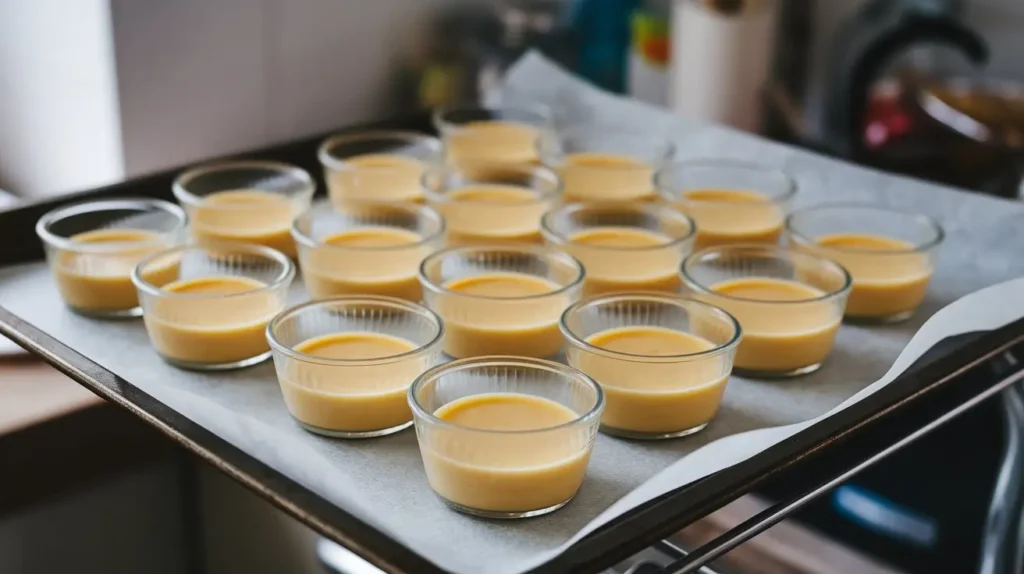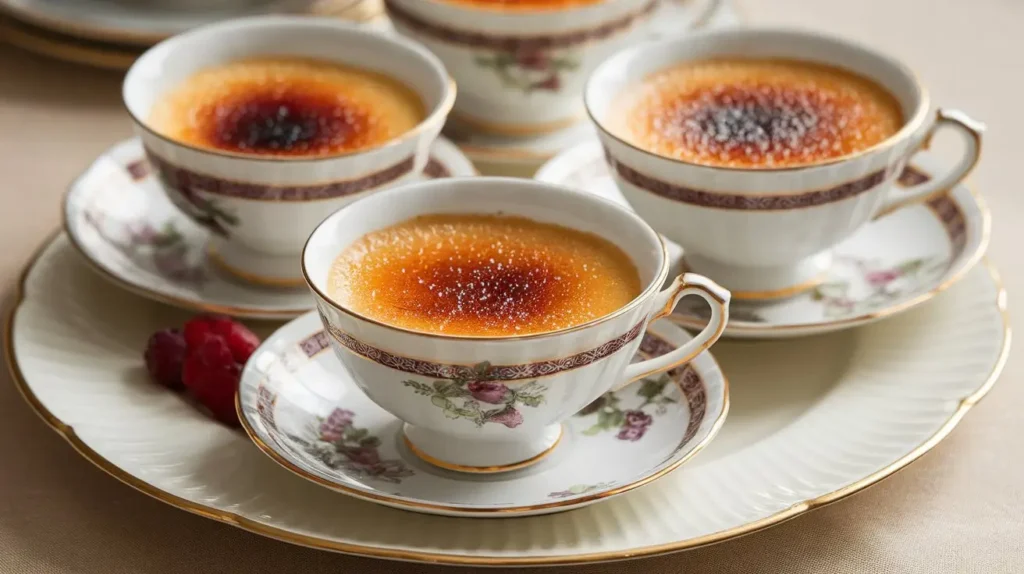Crème brûlée is one of those desserts that instantly elevates any occasion. Known for its creamy custard base and caramelized sugar topping, it’s a dessert that feels as elegant as it is indulgent. Traditionally, crème brûlée is prepared and served in ramekins—small, heat-resistant dishes that allow for perfect portioning and even cooking. But what happens if you don’t have ramekins on hand? Is it the end of your crème brûlée dreams? Absolutely not!
The good news is that there are plenty of alternatives to ramekins that you can use to create this French classic without compromising its taste, texture, or presentation. In this detailed guide, we’ll dive into practical substitutes for ramekins, explain why they work, and provide useful tips to ensure your crème brûlée turns out perfectly.
Why Are Ramekins the Go-To Choice for Crème Brûlée?
Before we explore alternatives, let’s take a moment to understand why ramekins are traditionally used for crème brûlée. These small, round, and shallow dishes are specifically designed to:
- Ensure Even Cooking: Their shallow depth allows the custard to cook uniformly, resulting in a silky-smooth texture.
- Support Caramelization: The wide opening of ramekins provides the perfect surface for torching sugar to create that signature crackling crust.
- Portion Control: Ramekins make it easy to create elegant individual servings.
- Oven Safety: Typically made from heat-resistant materials like ceramic or porcelain, ramekins are designed to handle high oven temperatures and the direct heat of a torch.
While ramekins are undoubtedly ideal, there are many other containers that can serve the same purpose.
What Can You Use Instead of Ramekins for Crème Brûlée?
Whether you’re looking for something readily available in your kitchen or want to experiment with a creative twist, here are some of the best alternatives to ramekins:
1. Using Small Glass Bowls Instead of Ramekins for Crème Brûlée
Glass bowls are one of the most accessible alternatives to ramekins. They are typically heat-resistant and widely available in most households.
- Why They Work: Glass bowls often mimic the dimensions of ramekins, especially if they’re shallow and wide.
- Tips for Success: Ensure the bowls are labeled oven-safe. Avoid sudden temperature changes (like placing them under the broiler right after removing them from the fridge) to prevent cracking.

2. Can You Use Mason Jars as Ramekins for Crème Brûlée?
Mason jars are versatile, charming, and perfect for a rustic presentation.
- Why They Work: Their sturdy glass design makes them oven-safe, and they come in sizes that are ideal for individual portions.
- Tips for Success: Use wide-mouth mason jars for easy filling and eating. Fill them only halfway, as deeper custard layers may not cook evenly. When caramelizing the sugar, avoid heating the metal rim or lid to prevent accidental burns.
3. Teacups : A Stylish Ramekin Substitute for Crème Brûlée
For an elegant twist, why not use teacups or coffee cups to make your crème brûlée?
- Why They Work: Porcelain or ceramic cups are oven-safe and provide a classy alternative.
- Tips for Success: Choose cups that are labeled as heat-resistant. Be mindful of the depth, as deeper cups may increase baking time.

4. Using Metal Tart Tins as a Ramekin Alternative for Crème Brûlée
Metal tart tins are another practical option, especially if you already have them in your baking collection.
- Why They Work: Their shallow depth and wide surface area make them excellent for baking custards and achieving a beautiful sugar crust.
- Tips for Success: Grease the tins lightly to ensure the custard doesn’t stick, and use a torch to caramelize the sugar for best results.
5. Making Crème Brûlée in a Shallow Baking Dish Instead of Ramekins
If you’re making crème brûlée for a group, a shallow baking dish can serve as a perfect replacement.
- Why They Work: These dishes allow you to prepare a family-style crème brûlée that can be scooped out for individual servings.
- Tips for Success: Choose a shallow dish for even cooking and bake it in a water bath, just as you would with ramekins.
6. Are Silicone Molds a Good Ramekin Substitute for Crème Brûlée?
Silicone molds are a modern and versatile tool for baking.
- Why They Work: Silicone molds are non-stick, heat-resistant, and easy to work with.
- Tips for Success: Place the molds on a baking tray for stability and remove the crème brûlée carefully after it has set. Use a torch gently when caramelizing sugar, as excessive heat can damage the mold.
7. Using Disposable Aluminum Cups for Crème Brûlée Without Ramekins
If you’re looking for a budget-friendly and disposable option, aluminum cups are a convenient choice.
- Why They Work: These lightweight cups are easy to handle and distribute heat evenly.
- Tips for Success: Line them up on a sturdy baking sheet for stability, and torch the sugar carefully, as aluminum can conduct heat very quickly.
8. Mini Soufflé Dishes
Soufflé dishes are similar to ramekins but typically larger and deeper.
- Why They Work: They’re made of the same heat-resistant materials as ramekins and are excellent for baking custards.
- Tips for Success: Since these dishes are deeper, you may need to extend the baking time slightly to ensure the custard sets properly.
9. Wide-Mouth Bowls
If none of the above options are available, a regular wide-mouth bowl can work in a pinch.
- Why They Work: Their shape provides a large surface area for caramelization.
- Tips for Success: Use heatproof bowls and monitor baking times carefully to prevent overcooking.
How to Adjust Your Crème Brûlée Recipe Without Ramekins
Switching from ramekins to alternative containers may require minor adjustments to your crème brûlée recipe:
1. Use a Water Bath (Bain-Marie)
No matter the container you choose, baking crème brûlée in a water bath is essential. This technique prevents the custard from curdling by creating a gentle and even heat.
- How to Set It Up: Place your chosen containers in a deep baking pan. Fill the pan with hot water until it reaches halfway up the sides of the containers. This helps regulate the temperature during baking.
2. Adjust Baking Time
The depth and material of your container will affect baking times:
- Shallow Containers: These will cook faster than ramekins, so start checking for doneness 5-10 minutes earlier.
- Deeper Containers: These may require additional baking time. Keep an eye on the custard to ensure it doesn’t overbake.
3. Test for Doneness
When the crème brûlée is done, the custard should be set around the edges but still slightly jiggly in the center. If you’re unsure, insert a toothpick near the edge—it should come out clean.
4. Caramelizing Sugar Without a Torch
If you don’t have a kitchen torch, you can still create the signature caramelized crust:
- Use your oven’s broiler setting.
- Place the containers as close to the broiler as possible without touching it.
- Watch carefully to avoid burning.
Creative Ways to Serve Crème Brûlée Without Ramekins
Using alternatives to ramekins opens up a world of possibilities for how you can present your crème brûlée:
- Rustic Vibe: Serve in mason jars or disposable aluminum cups for casual gatherings.
- Elegant Look: Use teacups or coffee cups for a more refined presentation.
- Family-Style Serving: A large baking dish allows guests to scoop out their portions.
Explore other unique brûlée recipes, like this Mouthwatering Crab Brûlée Recipe That’s Surprisingly Easy to Make
Common Questions About Ramekin Substitutes
1. Can I Use Pyrex Bowls for Crème Brûlée?
Yes, as long as they’re labeled oven-safe. Be cautious with sudden temperature changes to avoid cracking.
2. Are Disposable Aluminum Cups Safe for Crème Brûlée?
Yes, they are oven-safe and a convenient option for parties. Just be careful when torching the sugar topping.
3. What If My Containers Are Too Deep?
If your containers are deeper than ramekins, extend the baking time and check frequently to ensure even cooking.
4. How Do I Prevent My Crème Brûlée from Curdling?
Use a water bath, bake at a low temperature, and avoid overbaking.
5. Can I Skip the Sugar Topping?
While the caramelized sugar is a hallmark of crème brûlée, you can skip it or use an alternative topping, like fruit or whipped cream.
Conclusion
You don’t need ramekins to create a stunning crème brûlée. With a bit of creativity, plenty of practical substitutes—like mason jars, teacups, glass bowls, or baking dishes—can help you achieve the same rich custard and crackling caramelized sugar topping. Each alternative offers its own flair, from rustic charm to elegant sophistication, making it easy to adapt the dessert for any occasion.
When choosing a substitute, focus on shallow, oven-safe containers to ensure even cooking and a perfect texture. Adjust your baking time depending on the size and depth of the dish, and always use a water bath to prevent curdling. Whether you’re making individual servings or a family-style version, the essence of crème brûlée lies in its creamy base and satisfying sugar crust—not the container it’s served in.
So, don’t let the absence of ramekins stop you. With the options outlined here, you can confidently whip up this classic French dessert and impress your guests—or simply treat yourself—with a delicious, picture-perfect crème brûlée.

